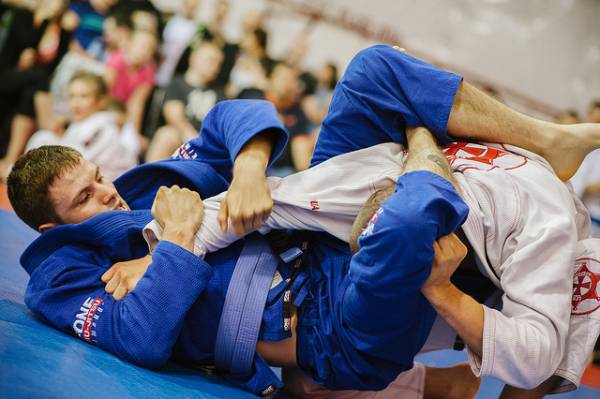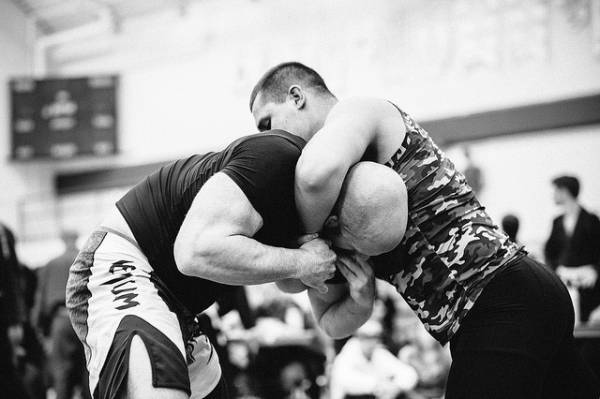We know a lot of you reading this site are BJJ and MMA practitioners, looking to get stronger, faster, and healthier so you can compete at your sport. For that reason, we are launching our newest free workout program – the MMA & BJJ strength and conditioning program.
This program will be an entire year in length and it’s designed by seasoned martial arts trainer Doug Dupont. Doug has been a long-time jiu jitsu practitioner himself and has trained professional MMA fighters, as well. Here, in his own words, he explains the first training phase and what the next year will look like for those who choose to take on his training program:
Training for combat sports such as MMA, BJJ, judo, wrestling, kickboxing, and boxing requires a great breadth of attributes. Unlike a powerlifter or a marathon runner, focusing on strength or endurance alone won’t cut it. You need to develop it all.
This workout will be a full year long, separated into four twelve-week phases and a final four-week phase.
In the first phase we will begin by developing all around general physical preparedness (GPP). In this phase you might notice a lack of exercises specific to MMA or BJJ. This is because we are working on your general fitness. The strength or endurance you develop in this first phase will carry over into any physical activity you do in life, and will form the foundation of the future phases of the program. The conditioning you develop during this time will be maintained through the future phases of training.
The phases that come later will continue to build on one aspect of your GPP – the second phase will focus on cardio, the third on strength, and the fourth on flexibility and mobility. The final four-week phase will be a cutting phase, for use in preparing for a fight or competition in which you need to lose some weight.
Each phase is a three day per week program, but if you have the time I encourage you to add 30-minute light cardio sessions with your heart rate under 150 on as many as three of the other days, assuming you find you are still fresh, have energy, and are not overtrained.
To determine your overtraining status and your improving fitness, take your heart rate every morning. I strongly recommend a heart rate monitor, but if you do not have one, take your heart rate at your wrist, not your neck. Remember you need a clock or timer that measures seconds. Take the heart rate for a full minute every morning after you get up and go to the bathroom, but before you do anything else. Make sure you are sitting. Record the number every day, and if it is increases by more than five beats per minute you are probably overtraining or getting sick.
 If you find you are overtraining, then cut back on your workouts, starting first with the sprint portions of the cardio, and then with some of the strength training if need be, or take the day off altogether. Once you have recovered begin adding back exercises slowly to find your limit. You may find that your resting heart rate drops over the twelve weeks. This is good, and it’s a sign that your cardio is improving.
If you find you are overtraining, then cut back on your workouts, starting first with the sprint portions of the cardio, and then with some of the strength training if need be, or take the day off altogether. Once you have recovered begin adding back exercises slowly to find your limit. You may find that your resting heart rate drops over the twelve weeks. This is good, and it’s a sign that your cardio is improving.
You will also note I do not use percentages of maximums, but rather what rep max you should be using for your weights. This is because I find this to be both more accurate, and simpler for most people to follow. As an example, if I write “3 x 5 with your 7-rep max,” this means you should do three sets of five repetitions with a weight that you could only lift seven times at most. However, you should be able to cleanly finish that seventh rep. If you have to seriously struggle and cheat a little to do that seventh rep, then it doesn’t count. Your 7-rep max is the weight where you could do seven very strict reps.
Note that this workout is very simple. For example, you might ask, “Only three sets of pressing for the first workout?” Yes. Do not do more than mentioned. Sometimes volume is low to allow you to adjust to the new program or to allow for strategic deconditioning. Also, combat athletes are among the most prone to overtraining, especially if they are training in their skilled disciplines three or more times per week. Given that scenario, this workout will be perfectly adequate for results.
For any exercise that says “for time” you should try to beat your previous time with each workout.
I don’t mark the rest periods in between sets or exercises. Rest as long as you need and approach each set as recovered as possible. Avoid failure. You should stop each set before you can’t lift any more, and rest longer if you need to so that you can follow along with the workout. The recommended starting weights assume familiarity with the exercises. If you are new to a program like this or are detrained, add a few reps to each rep max recommendation. For example, where it says “3 x 5 with your 8-rep max” instead, do 3 x 5 with your 10- or 11-rep max instead, as the work out will rapidly become too difficult to do with your 8-rep max.
 You will notice that this workout doesn’t change much from week to week. This is for good reason. Strength is a factor in both endurance and flexibility, and strength is developed, in part, by practice. The popular modern trends of highly variable workouts and “muscle confusion” are inefficient ways of exercising. As we move into different phases you will see new exercises, but for now stick to the workout as written.
You will notice that this workout doesn’t change much from week to week. This is for good reason. Strength is a factor in both endurance and flexibility, and strength is developed, in part, by practice. The popular modern trends of highly variable workouts and “muscle confusion” are inefficient ways of exercising. As we move into different phases you will see new exercises, but for now stick to the workout as written.
If you are near the top of your weight class, you may need to increase the load so that you can get stronger without adding as much muscle. If this is a concern, please feel free to leave a message below with this or any other questions.
If time allows, a week or so before you begin day one, you should test the following:
- Bench press and pullup or pulldown 8-rep maxes
- Deadlift 10 -rep max
- Overhead press and row 12-rep maxes
These are the weights you will be working with for the first phase of the program. Note that at the end of the first phase you will actually be doing more reps than your max at the start, so it may say something like “2 x 10 with your 10-rep max.” This is because by the end you should be stronger and fitter than when you started. In the following twelve-week phases we will re-evaluate your maxes.
Enjoy the workouts and let me know if you have any questions!
- Workout BJJ & MMA Cycle 1
- Workout BJJ & MMA Cycle 2
- Workout BJJ & MMA Cycle 3
- Workout BJJ & MMA Cycle 4
- Workout BJJ & MMA Cycle 5
- Workout BJJ & MMA Cycle 6
- Workout BJJ & MMA Cycle 7
Photos provided by David Brown Photography.






